The term “dyno-proven” has a nice ring to it, doesn’t it? Dyno testing has a way of determining whether or not certain combinations of parts work, and it allows you to simulate how a truck will perform on the street. For the finale of this series, it was time to face the music with our ’97 F-350, so we strapped it to the rollers at Randall’s Performance. If you recall, we upgraded our 7.3L’s pushrods and valvesprings in preparation for handling more horsepower (May ’12), as well as added the supporting modifications needed to get us there: a new turbo mounting system, turbo, and bigger intercooler (Sept. ’12).

| 500hp Power Stroke Part 4 1997 Ford F 350 On Dyno
In addition to measuring the truck’s horsepower, we kept an eye on a host of other items vital to overall performance. We monitored the new turbo’s drive pressure-to-boost ratio, made sure our high-pressure oil system was still holding strong, and we even pitted a stock Super Duty lift pump against an aftermarket pump. We also discovered that some modified ’94½ to ’97 7.3L engines might, in fact, need boost foolers. Once the wheels stopped turning, the dyno told us the turbo and intercooler upgrades alone (without any PCM tuning changes) provided significant gains. Read on to see how we cracked the 500hp barrier with our 7.3L Power Stroke.

| Taking advantage of Gearhead Automotive’s lifetime free reburn policy, we sent in our TS Performance six-position chip for a different tuning arrangement—one that called for a new performance setting capable of getting us to 500 hp. We also retained our previous performance setting (good for 436 rwhp, Aug. ’11) as a position on the chip so we could see—all else being equal—what the higher-flowing turbo system and intercooler gained us.
Parts List
Total $247.34
Part:
Vendor:
Details
Price:
Walbro lift pump
Summit Racing
Upgraded (universal) electric lift pump capable of flowing 255 lph, PN GSL392
$112.95
Overboost Annihilator
Strictly Diesel
Boost fooler prevents finicky ’94½ to ’97 MAP sensor from seeing excessive low-rpm boost
$59.95
Drive pressure gauge
Auto Meter
100-psi boost gauge to monitor drive pressure-to-boost ratio, PN 4306
$56.95 (Summit Racing)
Snubber
Auto Meter
Reduces pressure spikes resulting in gauge fluctuation, PN 3279
$17.49 (Summit Racing)
500hp 7.3L Recipe
Although we’ve added many parts to our ’97 F-350 over the years, this is the list of modifications we used to break the 500hp mark.
John Wood Automotive Street Performance E4OD transmission
Unlimited Diesel Performance 238/80 hybrid injectors
DieselSite Adrenaline high-pressure oil pump
DieselSite CPR electric fuel system
Walbro lift pump
Irate Diesel Performance T4 turbo system
Fleece Performance S366 turbo
Spearco intercooler
ARP head studs
Comp Cams 910-16 valvesprings
Hamilton Cams pushrods
Gearhead Automotive Performance chip
MBRP 4-inch exhaust
K&N air intake
Total Investment $14,300
Driving Impressions
Obviously, the truck is more fun to drive now than it’s ever been—but not just because of the extra 70 hp on tap. Thanks to the turbo and improved airflow to the engine, it spools faster, responds quicker going down the highway, and pulls harder up top. The best way to describe how responsive the truck feels is by comparing it to when we had Stage 1 injectors and the stock turbo. Of course, it makes twice the power now, is virtually smokeless, and runs much cooler. As we go to press, we’ve seen as much as 43 pounds of boost on the street, so we could easily be making 15 to 25 more hp than what we saw on the dyno.
Super Duty Lift Pump Vs. Walbro
Thanks to fuel pressure dropping like a rock with the Super Duty pump still on the truck, our first full-power dyno run yielded 493 hp and 902 lb-ft (remember, limited timing advance at low rpm keeps cylinder pressure at bay in order to help the stock bottom end survive but also leads to a lower torque number). Dropping fuel pressure is a common problem for Super Duty owners running larger injectors.
Fuel Pressure (idle): 65 psi
Fuel Pressure (WOT): 20 psi

| Planning ahead, we brought this Walbro GSL392 aftermarket lift pump with us. The high-pressure inline pump is popular with the 7.3L community for its affordability, reliability, and simplicity. It’s a direct bolt-in replacement for a factory ’99 to ’03 pump and can easily support 500hp applications.
In the end, the Walbro pump’s ability to provide consistent fuel pressure made the difference. And after months of planning, we hit our mark: 502 hp at 3,000 rpm. Throughout the dyno pull, fuel pressure didn’t move off of 65 psi. The truck itself seemed more eager to run as well, pulling harder up top (we were still making 470 hp at 3,500 rpm. Check out all the data we collected during our 500hp run below.
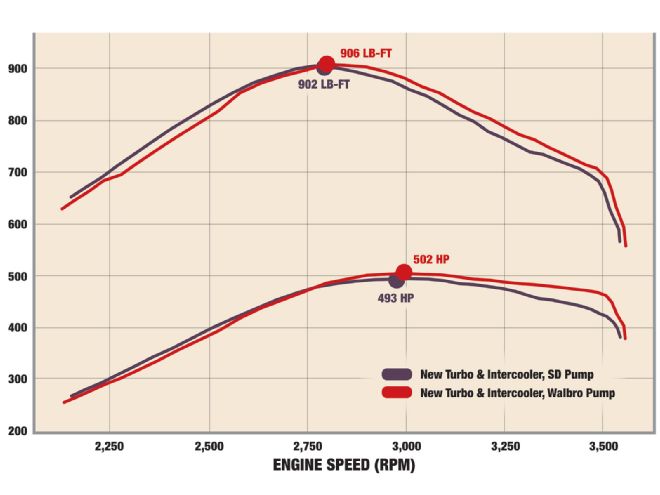
| 500hp Power Stroke Part 4 super Duty Lift Pump Vs Walbro Graph
Fuel Pressure (idle): 65 psi
Fuel Pressure (WOT): 65 psi
Peak boost pressure: 38 psi
Peak drive pressure: 58 psi
Drive-to-boost ratio: 1.5:1
Injection control pressure: 3,100 psi
IPR duty cycle: 42 percent
Peak EGT: 1,400 degrees
*SuperFlow correction factor
*30 percent load applied
*Third gear (1:1), torque converter locked
*Boost and EGT peak higher on the street
This comparison shows how—without any PCM tuning changes—the S366, Spearco intercooler, and Walbro pump upgrades yielded a 40hp gain over our old setup (modified stock turbo, smaller intercooler, Super Duty lift pump). We think it’s a true testament to how great airflow, improved air-to-air cooling, and consistent fuel pressure make all the difference in the world.
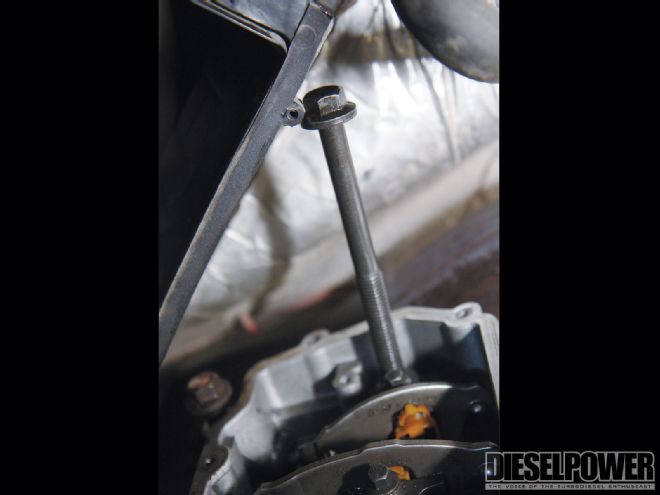
| 500hp Power Stroke Part 4 turbo Intercooler And Lift Pump Power Graph
Old Setup
Peak Boost: 35 to 36 psi
Peak EGT: 1,400 degrees
New Setup
Peak Boost: 35 psi
Peak EGT: 1,200 degrees
*Same performance tune
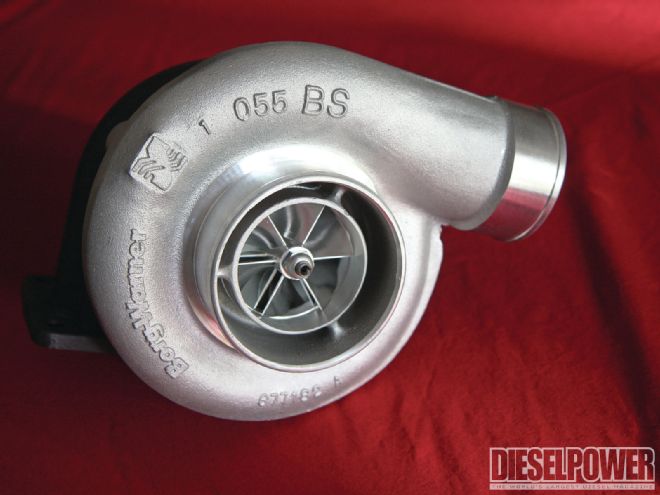
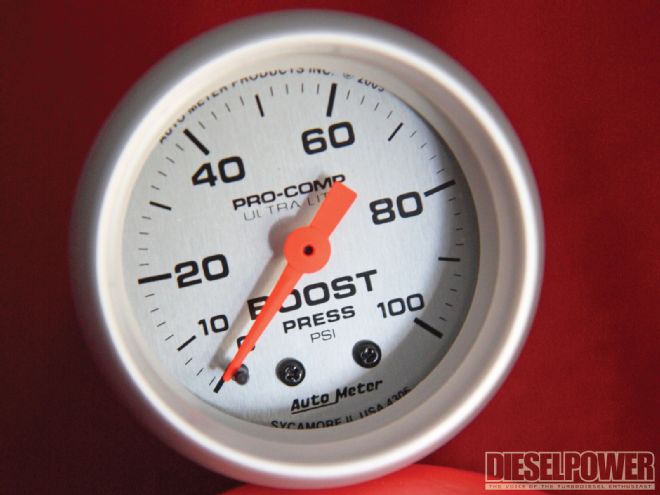
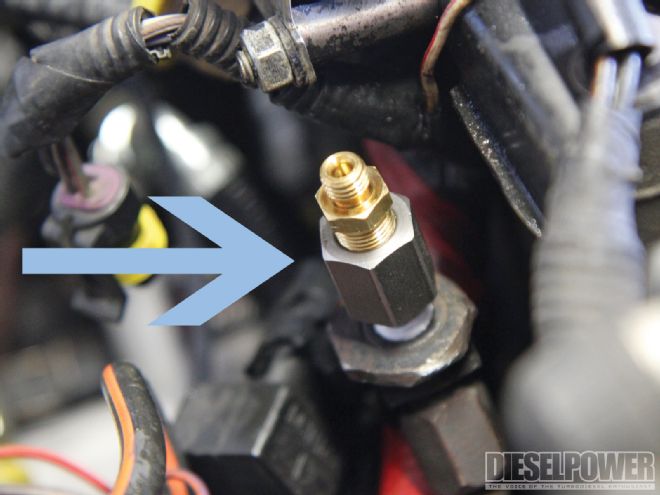
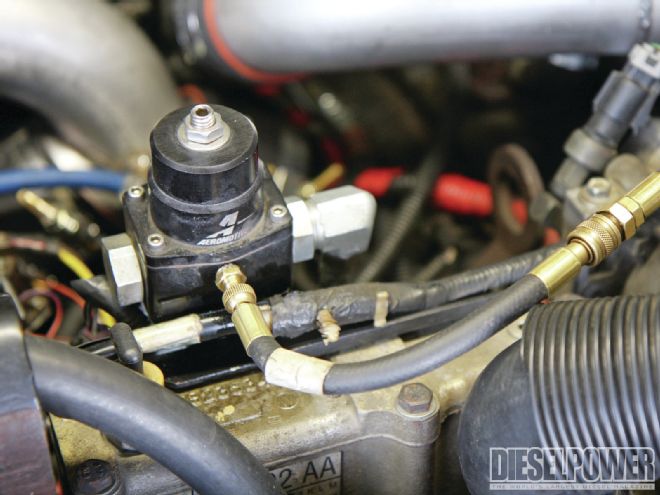

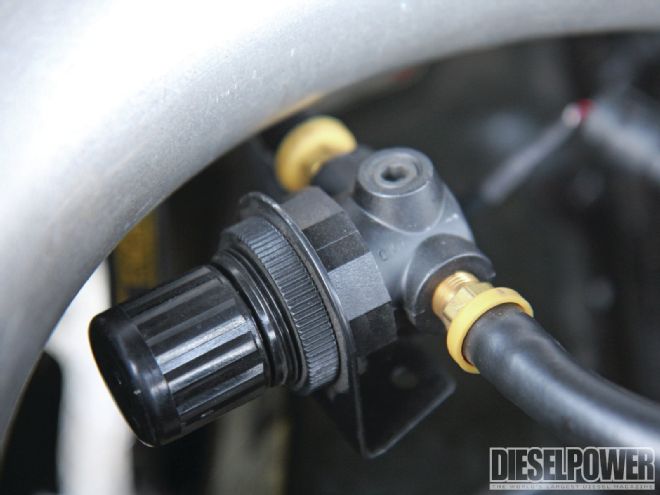
 | 500hp Power Stroke Part 4 super Duty Lift Pump Vs Walbro Graph
Fuel Pressure (idle): 65 psi
| 500hp Power Stroke Part 4 super Duty Lift Pump Vs Walbro Graph
Fuel Pressure (idle): 65 psi | 500hp Power Stroke Part 4 turbo Intercooler And Lift Pump Power Graph
Old Setup
| 500hp Power Stroke Part 4 turbo Intercooler And Lift Pump Power Graph
Old Setup